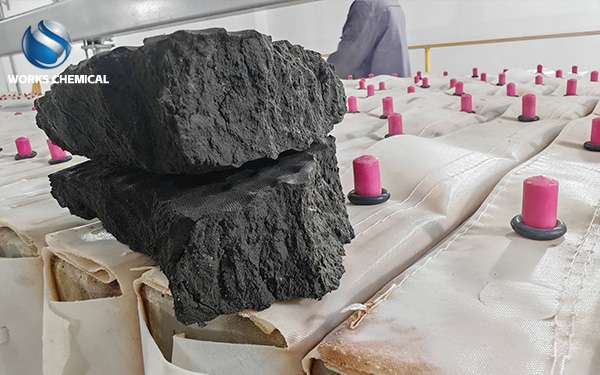
Municipal sludge, as a by-product generated in the urban sewage treatment process, is complex in composition and has a huge output. It contains a large amount of organic matter, microorganisms, heavy metals and various colloidal substances. Its proper treatment is an important link in urban environmental governance. Traditional municipal sludge treatment often encounters problems such as difficult dewatering, low treatment efficiency and high cost. However, the application of sludge enhancers provides strong support for solving these problems and has become a key technical means in the field of municipal sludge treatment.

The characteristics of municipal sludge have brought many challenges to the treatment work. On the one hand, municipal sludge contains a large number of colloidal particles, which carry negative charges on their surfaces and repel each other, making it difficult for them to coagulate and form larger flocs. This results in poor sedimentation and filtration performance of the sludge, and during the dewatering process, water is hard to separate quickly, leading to a persistently high moisture content in the filter cake. On the other hand, the viscosity of municipal sludge is relatively high. During the treatment process, it is prone to clogging the filter cloth or pipes of the treatment equipment, which not only affects the treatment efficiency but also increases the maintenance cost of the equipment. In addition, municipal sludge has a high content of organic matter and is prone to rot and stink. If it is not treated in time or thoroughly, it will also cause secondary pollution to the surrounding environment.
The reason why sludge enhancers can play a significant role in municipal sludge treatment lies in their precise adaptability to the characteristics of municipal sludge. The charge problem of colloidal particles in municipal sludge can be precisely solved by the charge neutralization effect of sludge enhancers. The effective components in the sludge enhancer can adsorb on the surface of colloidal particles, neutralize their surface charges, eliminate the repulsive force between particles, and then coagulate with each other to form large flocs with loose structure and well-developed pores. These large flocs significantly enhance the filtration performance of the sludge, allowing water to pass through the filter cloth more smoothly and be discharged, effectively reducing the moisture content of the filter cake.
Meanwhile, for the problem of high viscosity of municipal sludge, sludge enhancers can also play a very good role in improvement. It can penetrate between sludge particles, alter the surface properties and interaction forces of the particles, reduce the viscosity of the sludge, and enhance its fluidity. In this way, during the filtration and other treatment processes, the sludge can be distributed more evenly, reducing the clogging of the filter cloth, shortening the filtration cycle and improving the treatment efficiency.
In the actual application of municipal sludge treatment, the effect of sludge enhancers has been fully verified. A certain urban sewage treatment plant generates a large amount of municipal sludge every day. When traditional treatment methods are adopted, the moisture content of the filter cake remains above 80% all the time. This not only leads to high transportation costs but also makes subsequent disposal very difficult. After the introduction of the sludge enhancer, by reasonably controlling the dosage and treatment process, the moisture content of the filter cake was reduced to below 70%. This not only reduces the volume of sludge and lowers transportation costs, but also creates favorable conditions for subsequent resource utilization, such as making organic fertilizers, etc. In addition, due to the enhanced fluidity of sludge, the phenomenon of filter cloth clogging has been significantly reduced, the operation cycle of the filter press has been prolonged, the frequency of equipment maintenance has decreased, and the human and material costs in the treatment process have been greatly lowered.
Of course, when using sludge enhancers in municipal sludge treatment, some key points also need to be noted. Firstly, a comprehensive test of the properties of municipal sludge should be conducted, including pH value, organic matter content, and the charge of colloidal particles, etc. Based on the test results, the appropriate type of sludge enhancer should be selected to ensure its effectiveness. Secondly, the optimal dosage should be determined through small-scale tests. A dosage that is too small may not achieve the desired treatment effect, while a dosage that is too large will increase costs and may even have adverse effects on the subsequent treatment of sludge. Finally, in light of the process characteristics of municipal sludge treatment, the operating parameters of the treatment equipment should be reasonably adjusted, such as the pressure of the filter press and the filtration time, to ensure that the sludge enhancer is perfectly coordinated with the treatment process and achieves the maximum efficiency.
With the continuous acceleration of urbanization, the output of municipal sludge will continue to increase, and the requirements for sludge treatment will also become increasingly higher. Sludge enhancers, with their significant advantages in enhancing treatment efficiency, reducing treatment costs and improving treatment effects, will have a broader application prospect in municipal sludge treatment. In the future, with the continuous innovation and upgrading of technology, the performance of sludge enhancers will be further enhanced. They will surely play a more significant role in the reduction, harmless treatment and resource utilization of municipal sludge, contributing to the improvement of the urban environment and sustainable development.